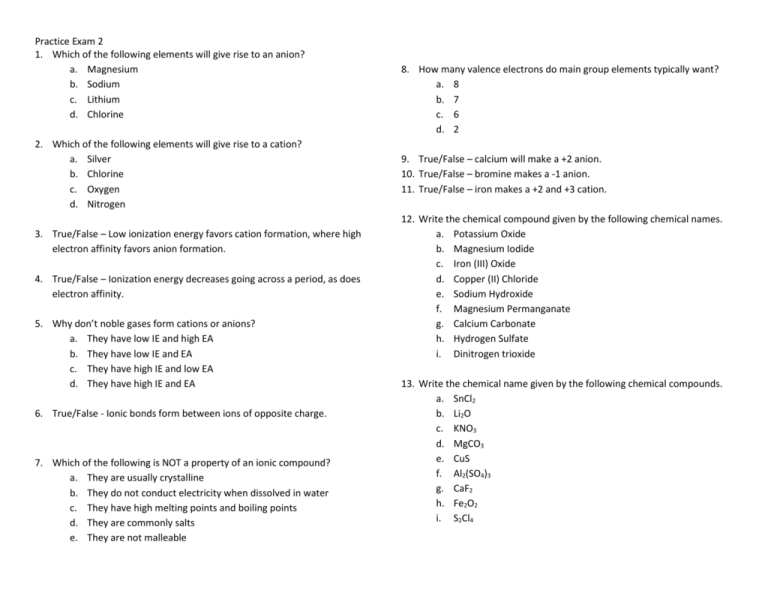File
advertisement

Practice Exam 2 1. Which of the following elements will give rise to an anion? a. Magnesium b. Sodium c. Lithium d. Chlorine 2. Which of the following elements will give rise to a cation? a. Silver b. Chlorine c. Oxygen d. Nitrogen 3. True/False – Low ionization energy favors cation formation, where high electron affinity favors anion formation. 4. True/False – Ionization energy decreases going across a period, as does electron affinity. 5. Why don’t noble gases form cations or anions? a. They have low IE and high EA b. They have low IE and EA c. They have high IE and low EA d. They have high IE and EA 6. True/False - Ionic bonds form between ions of opposite charge. 7. Which of the following is NOT a property of an ionic compound? a. They are usually crystalline b. They do not conduct electricity when dissolved in water c. They have high melting points and boiling points d. They are commonly salts e. They are not malleable 8. How many valence electrons do main group elements typically want? a. 8 b. 7 c. 6 d. 2 9. True/False – calcium will make a +2 anion. 10. True/False – bromine makes a -1 anion. 11. True/False – iron makes a +2 and +3 cation. 12. Write the chemical compound given by the following chemical names. a. Potassium Oxide b. Magnesium Iodide c. Iron (III) Oxide d. Copper (II) Chloride e. Sodium Hydroxide f. Magnesium Permanganate g. Calcium Carbonate h. Hydrogen Sulfate i. Dinitrogen trioxide 13. Write the chemical name given by the following chemical compounds. a. SnCl2 b. Li2O c. KNO3 d. MgCO3 e. CuS f. Al2(SO4)3 g. CaF2 h. Fe2O2 i. S2Cl4 Practice Exam 2 14. True/False – a covalent bond is formed when attractive forces of two atoms are greater than the repulsive forces. 15. How many electrons are shared between two atoms bonded together by a double bond? a. 2 b. 3 c. 4 d. 5 16. The distance between nuclei at the optimal, minimum energy point is called… a. Bond strength b. Bond order c. Bond length d. Bond number 17. True/False – nitrogen, oxygen, chlorine, hydrogen, fluorine, and helium form diatomic molecules. 18. How many bonds does fluorine need to make to achieve an octet? a. 4 b. 3 c. 2 d. 1 19. How many bonds does carbon need to make to achieve an octet? a. 4 b. 3 c. 2 d. 1 20. True/False – carbon, nitrogen, and oxygen most frequently make multiple bonds (double, triple bonds) 21. True/False – unshared pairs of electrons are called lone pairs. 22. Draw the Lewis structure for water, CCl4, and N2. 23. True/False – nitrogen forms three covalent bonds and has one lone pair of electrons. 24. True/False – oxygen forms two covalent bonds, with two lone pairs of electrons. 25. Tetrahedral molecules have bond angles of a. 180 degrees b. 90 degrees c. 109.5 degrees d. 120 degrees 26. Polar covalent bonds are when a. Bonded atoms are not equal and there is an unequal balance of charge b. There is no flow of electrons c. There is equal attraction between bonded atoms d. There are no dipoles 27. Electronegativity, an atom’s ability to attract electrons,… Practice Exam 2 a. Increases going up and across the periodic table, making fluorine the most electronegative element b. Increases going down each group on the periodic table c. Decreases going diagonally across the periodic table, starting at Francium (Fr) d. Decreases going across periods 28. True/False – if the difference in electronegativity between to bonded atoms is greater than 2, the bond is likely polar covalent. 29. Dipoles (polarity) are represented in molecules by drawing arrows pointing towards the a. Negative end of the molecule b. Positive end of the molecule c. Center of the molecule d. Bigger end of the molecule 30. If all the dipoles in a molecule effectively cancel out with each other (a frequent occurrence with symmetrical shapes), a. The molecule is still polar b. The molecule is nonpolar c. The molecule is charged d. The molecule is diatomic 31. Which of the following is NOT a property of molecular compounds? a. Low melting points/boiling points b. Soluble in organic liquids c. Most are water soluble d. Made up of mostly nonmetals 32. True/False – reactants are found on the left side of the reaction arrow, and products are found on the right side of the reaction arrow. 33. True/False – Avogadro’s number is the equivalent of one mole. 34. True/False – molar mass is in units of grams/mol and can be used as a conversion factor 35. How many moles of water do I have if I have 36.0 grams of water? (molar mass for water is 18.0 grams) a. 1 b. 2 c. 3 d. 4 36. A molar ratio relates which of the following? a. The coefficients of two species in a reaction b. The molar masses of reactants c. The molar masses of products d. Exponents of two species in a reaction 37. Which of the following equations are balanced? Balance those that need it. Practice Exam 2 38. 42. 42. 39. 40. 41.




![QUIZ 2: Week of 09.03.12 Name: [7pts] 1.) Thoughtful list of 3](http://s3.studylib.net/store/data/006619037_1-3340fd6e4f1f4575c6d8cf5f79f0ff3e-300x300.png)






